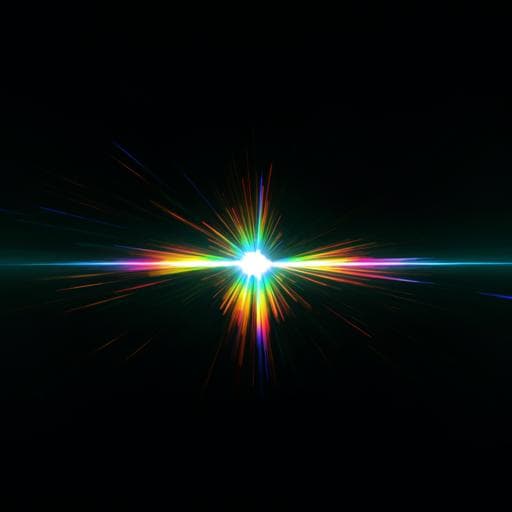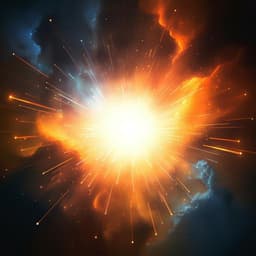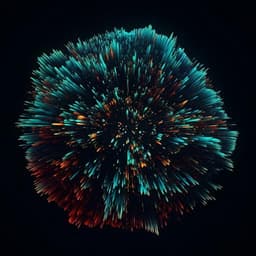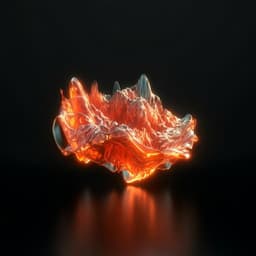
Engineering and Technology
Single-shot ultrafast imaging attaining 70 trillion frames per second
P. Wang, J. Liang, et al.
Discover the groundbreaking Compressed Ultrafast Spectral Photography (CUSP), a transformative imaging technique achieving up to 70 trillion frames per second! Conducted by pioneering researchers Peng Wang, Jinyang Liang, and Lihong V. Wang, this study showcases the potential of CUSP in real-time imaging of rapid nonlinear light-matter interactions and fluorescence lifetime imaging microscopy.
~3 min • Beginner • English
Introduction
Ultrafast phenomena in physics, chemistry, biology, and materials science—such as ultrashort light propagation, molecular radical decay, soliton formation, shock waves, and nonlinear interactions—require frame rates at or beyond the trillion-fps regime to observe in real time. Conventional electronic sensors (CCD/CMOS) reach up to millions of fps and cannot capture such dynamics. The prevalent pump–probe method reconstructs events by repeated measurements with varied delays, precluding real-time single-shot observation and limiting applicability to highly repeatable phenomena. Addressing the longstanding challenge of real-time ultrafast imaging, the work introduces a modality capable of single-shot multi-dimensional capture at unprecedented speeds and sequence depths, enabling direct observation of non-repeatable or stochastic ultrafast events.
Literature Review
Recent trillion-fps imaging solutions include sequentially-timed all-optical imaging photography, frequency-dividing imaging, non-collinear optical parametric amplification, frequency-domain streak imaging, and compressed ultrafast photography (CUP). While impactful, these methods have not exceeded ~10 Tfps and involve trade-offs such as limited imaging depth, scaling complexity with sequence depth, or constraints imposed by streak camera electron deflection and pixel counts, which cap sequence depth (e.g., ~300 frames for CUP). The pump–probe approach remains widely used but lacks true real-time single-shot capability and requires event repetition. The literature context motivates an approach that surpasses both speed and sequence depth limitations while enabling multi-dimensional capture.
Methodology
CUSP combines spectral encoding, pulse splitting, temporal shearing, and compressed sensing to achieve single-shot ultrafast imaging.
- System architecture: The dynamic scene is imaged and split into two paths. One path forms an external, time-unsheared, spectrum-undispersed reference image (u-View). The other path is spatially encoded by a digital micromirror device (DMD) with a static pseudo-random binary mask, then passed to a streak camera with a fully opened entrance aperture.
- Spectral dispersion and temporal shearing: A diffraction grating disperses the encoded scene spectrally in the horizontal direction (x). Inside the streak tube, a fast sweeping voltage temporally shears the photoelectron image in the vertical direction (y), followed by detection by an internal camera, producing a time-sheared, spectrum-dispersed measurement (s-View).
- Active mode illumination: A broadband femtosecond pulse is converted into a temporally linearly chirped pulse train via a pair of high-reflectivity beam splitters and a glass rod. Neighboring sub-pulses are separated by a tunable interval. Spatial chirp is imparted using a grating pair, and temporal chirp is balanced to match spectral-time resolution trade-offs. The illumination encodes time into wavelength (spectrotemporal encoding) so that successive frames correspond to successive sub-pulses with distinct wavelengths.
- Passive mode (SR-FLIM): The system records 4D data (x, y, t, λ) in a single shot at sub-terahertz rates, enabling spectrally resolved fluorescence lifetime imaging microscopy without repetitive acquisition.
- Image formation and reconstruction: The u-View and s-View measurements constitute an underdetermined inverse problem modeled by a joint forward operator incorporating spatial encoding, optical transfer functions, spectral dispersion, detector quantum efficiencies, temporal shearing, and integration. Reconstruction solves a regularized minimization problem to recover the dynamic scene I(x, y, t) (and spectral dimensions as applicable), leveraging sparsity priors (e.g., total variation) and calibration of system parameters.
- Performance characterization and limits: Temporal resolution in active mode is time–bandwidth limited by the illumination bandwidth and applied chirp. Sequence depth and field-of-view (FOV) are interdependent and bounded by streak camera sensor dimensions and shearing parameters. Derived expressions indicate, for typical configurations, over 10^3 frames in a single snapshot with recording windows on the order of tens of picoseconds.
- Experimental demonstrations: (1) Ultrafast linear optics: Imaging a chirped pulse train sweeping across a printed sample with controlled spectral-temporal mapping. (2) Ultrafast nonlinear optics: Single-shot Kerr-gate imaging of an intense 48-fs gate pulse propagating in a Bi2GeO3 (BGO) slab, with orthogonal detection geometry and crossed polarizers (+45°/−45°). (3) Passive SR-FLIM: Wide-field fluorescence microscopy integrated with passive CUSP to reconstruct spatially and spectrally resolved lifetime maps for Rhodamine 6G samples at multiple concentrations.
Key Findings
- Record speed and sequence depth: Active CUSP achieves 7 × 10^13 fps (70 Tfps) with ~10^3 frames in a single shot; passive CUSP attains 0.5 × 10^12 fps for 4D spectral imaging enabling single-shot SR-FLIM.
- Linear optics demonstration: Reconstructed frames over a 12.13 mm × 9.03 mm FOV show sub-pulses sweeping left-to-right with wavelength varying over time due to spatial chirp. At a fixed point, five peaks (five sub-pulses) exhibit an average FWHM temporal point-spread function of ~240 fs, corresponding to ~4.5 nm spectral resolution. Fourier-transform analysis yields a transform-limited FWHM of ~257 fs, indicating near-optimal operation relative to bandwidth and chirp.
- Comparison to T-CUP: For comparable conditions, CUSP maintains similar temporal spread while offering a higher number of frames within the same time window, surpassing prior record systems in both temporal resolution and sequence depth. Spectrally integrated intensities across sub-pulses match spectrometer ground truth.
- Nonlinear optics (Kerr gate in BGO): Single-shot 3D reconstructions of a ~980-fs event visualize the gate pulse propagation and focusing; transmittance grows with accumulated phase. The locally normalized transmittance at a fixed point has an FWHM of ~455 fs; deconvolution with the system temporal PSF yields a relaxation time of ~380 fs, consistent with literature. Gate peak power density at focus: ~5.6 × 10^14 W·cm^−2.
- Sequence depth and recording windows: With given sensor parameters, active CUSP can reach ~1120 frames with a recording time of ~16 ps; passive CUSP example yields ~315 frames over ~82.6 ps.
- SR-FLIM results: Single-shot spectrally resolved lifetime maps for Rhodamine 6G at varying concentrations show that average fluorescence lifetime decreases with increasing concentration, contrary to common assumptions. The required single-shot exposure time is >10^7× shorter than typical TCSPC acquisitions.
Discussion
The results demonstrate real-time, single-shot capture of femtosecond dynamics with speeds and sequence depths previously unattainable. By encoding time into wavelength orthogonally to streak shearing and splitting the illumination into chirped sub-pulses, CUSP breaks past the ~10 Tfps barrier and the sequence-depth limits imposed by streak sensor pixel counts. This enables quantitative measurements of ultrafast nonlinear phenomena (e.g., Kerr-induced birefringence dynamics) and validates temporal resolution close to the time–bandwidth limit. Passive operation extends capabilities to 4D SR-FLIM in a single exposure, vastly reducing acquisition times relative to TCSPC and revealing concentration-dependent lifetime behavior. Beyond surpassing pump–probe constraints (event repetition), CUSP is applicable to non-repeatable, random, or high-energy events that cannot be readily pumped or synchronized. The method scales across spectral bands (potentially from X-ray to NIR) and offers higher photon throughput than many ultrafast techniques. Trade-offs between FOV and sequence depth are quantifiable, informing system design for targeted applications.
Conclusion
CUSP introduces a single-shot ultrafast imaging paradigm that achieves 70 Tfps with ~10^3 frames in active mode and delivers single-shot 4D spectral imaging at 0.5 Tfps in passive mode, enabling applications such as SR-FLIM. It quantitatively captures ultrafast linear and nonlinear light–matter interactions and uncovers concentration-dependent fluorescence lifetimes in single shots. The approach overcomes key limitations of existing methods (speed, sequence depth, need for event repetition) and is broadly extensible across spectral regions and modalities. Future directions include improving spatial resolution via advanced encoding (e.g., lossless coding, multi-view projection), pushing temporal resolution beyond time–bandwidth limits (e.g., polarization encoding), replacing electronic streaking with optical shearing to avoid electronic bottlenecks, and leveraging machine learning for faster and more robust reconstructions.
Limitations
- Spatial resolution degradation of approximately 2–3× due to compressed sensing multiplexing and encoding mask limitations.
- Temporal resolution in active mode is fundamentally limited by illumination time–bandwidth constraints; passive mode speed is constrained by streak camera performance (quantum efficiency, space-charge effects, electronic jitter).
- Reconstruction accuracy depends on accurate calibration and the sparsity of the dynamic scene; performance may degrade for non-sparse or highly complex scenes.
- Trade-off between sequence depth and field of view due to finite detector pixel counts and shearing constraints; maximum FOV decreases as sequence depth increases.
- Code is proprietary and not publicly available; data are available upon reasonable request, which may affect reproducibility.
- For random phenomena, reliable triggering remains necessary; some applications may still face practical limitations in source and detector availability across spectral regimes.
Related Publications
Explore these studies to deepen your understanding of the subject.







